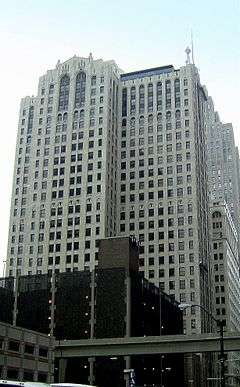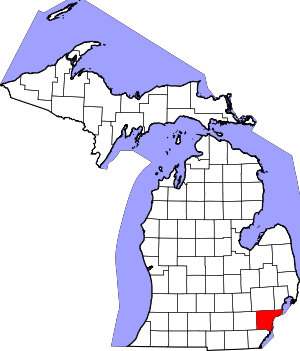Buhl Building
The Buhl Building is a skyscraper and class-A office center in Downtown Detroit, Michigan. Architect Wirt C. Rowland designed the Buhl in a Neo-Gothic style with Romanesque accents. Constructed in 1925, it stands at 26 stories in the Detroit Financial District across Congress Street from the Penobscot Building and across Griswold Street from the Guardian Building, all of which were designed by Wirt C. Rowland. The Buhl Building stands on the corner of Congress St. West, and Griswold St. in Downtown Detroit. The building stands atop what used to be the Savoyard Creek near its confluence with the Detroit River. In 1836, the creek was covered and turned into a sewer. The Savoyard Club occupied the 27th floor of the Buhl Building from 1928 until its membership dwindled and the club closed in 1994. Suburban Mobility Authority for Regional Transportation has its headquarters in the building.
| Buhl Building | |
|---|---|
 | |

| |
| General information | |
| Type | Commercial offices |
| Location | 535 Griswold Street Detroit, Michigan |
| Coordinates | 42.3294°N 83.0469°W |
| Completed | 1925 |
| Height | |
| Roof | 111.6 m (366 ft) |
| Top floor | 107.0 m (351.0 ft) |
| Technical details | |
| Floor count | 29 |
| Floor area | 482,454 sq ft (44,821.4 m2) |
| Design and construction | |
| Architect | Wirt C. Rowland SmithGroup |
Buhl Building | |
| Architectural style | Neo-Gothic / Romanesque |
| Part of | Detroit Financial District (ID09001067) |
| Designated CP | December 14, 2009 |
| References | |
| [1][2][3] | |
Hubbell, Roth & Clark, Inc. (HRC) is a Michigan Civil Engineering firm celebrating 100 years in business. HRC's Detroit Office is located on the 16th floor of the Buhl Building.
The Citizen's Bank Building in downtown Saginaw, Michigan was modeled after the Buhl Building.
The architectural sculpture on the building was designed by Corrado Parducci.
Architect
Wirt C. Rowland, designer of the Penobscot Building, Guardian Building, and the Buhl Building was born and raised in Clinton, Michigan. In 1901, he landed a job as an office boy for the Detroit firm of Rogers & MacFarlane, quickly moving on to the prestigious George D. Mason firm. In 1909, he joined the office of Albert Kahn, who had also apprenticed under Mason. In 1910, with the encouragement of both Mason and Kahn, Rowland attended the Harvard Graduate School of Design in Cambridge, MA for a year.
The combination of Rowland's natural design talent, Harvard education, and Detroit's healthy economy positioned him to make major contributions to the city's architecture. Rowland is a case study in design attribution. In 1911, in the office of Kahn, he and Ernest Wilby are said to have been primarily responsible for the Hill Auditorium at the University of Michigan. Rowland worked for the local firm of Malcomson & Higginbotham until 1915. He then returned to Kahn's office, contributing to the firm's classic projects, namely the Hatcher Graduate Library at the University of Michigan, the Detroit News Building, the First National Building (1922), and the General Motors Building (1922) renamed Cadillac Place.
Rowland's career peaked as Head Designer (1922–1930) of Smith, Hinchman & Grylls (SmithGroup). There, he designed a dozen major structures in downtown Detroit; among these are a number of the city's most accomplished and evocative buildings. To a large extent, Rowland helped define Detroit's architectural genre. For the Guardian Building, he had assembled a multitude of artisans, mosaicists, sculptors, painters, and tile manufacturers including Corrado Parducci, muralist Ezra Winter, and tile from the Rookwood and Pewabic pottery companies. He thus recreated the architectural synthesis of a medieval cathedral. Hence, Rowland had reached a climax when his Union Trust/Guardian Building became known as "the Cathedral of Finance."
The Guardian Building opened in 1930. With the onset of the Great Depression, Rowland was laid off from Smith, Hinchman & Grylls. As a result, he formed his own office where his work decreased to a small number of churches, schools and construction projects. Late in life, he returned to a purer, Gothic idiom for his last few projects, notably the Kirk in the Hills church which was built after he died in 1946. During World War II, the Guardian Building would serve as headquarters for war time production.
Tenants
Suburban Mobility Authority for Regional Transportation has its headquarters in the building,[4] and the Consulate of Italy in Detroit is located in Suite 1840.[5] Fink + Associates Law's Detroit office is located in Suite 1000.
At one time Real Times Media, the owner of black newspapers in the US, had its headquarters in the building.[6]
Michigan Nonprofit Association, a statewide membership organization that serves the nonprofit sector, has its Metro Detroit office in the Buhl Building.[7]
Gallery
 Buhl Building, circa 1920
Buhl Building, circa 1920 Buhl Building in the shadow of the Penobscot Building
Buhl Building in the shadow of the Penobscot Building
See also
References
- Buhl Building at Emporis
- "Buhl Building". SkyscraperPage.
- Buhl Building at Structurae
- "Contact SMART". Suburban Mobility Authority for Regional Transportation. 2011. Retrieved November 15, 2011.
- "Welcome to the web site of the Consulate of Italy in Detroit". Consulate of Italy in Detroit. 2011. Retrieved November 15, 2011.
- "Home." () Real Times Media. December 3, 2007. Retrieved on December 11, 2013. "Headquarters: The Buhl Building • 535 Griswold Street • Suite 1300 • Detroit, MI • 48226 "
- "Michigan Nonprofit Association - Contact Us". Retrieved December 3, 2015.
Further reading
- Hill, Eric J.; Gallagher, John (2002). AIA Detroit: The American Institute of Architects Guide to Detroit Architecture. Detroit: Wayne State University Press. ISBN 978-0-8143-3120-0.
- Kvaran, Einar Einarsson, Shadowing Parducci, unpublished manuscript, Detroit.
- Meyer, Katherine Mattingly; McElroy, Martin C. P. (1980). Detroit Architecture A. I. A. Guide. Introduction by W. Hawkins Ferry, Hon A.I.A. (Revised ed.). Detroit: Wayne State University Press. ISBN 978-0-8143-1651-1.
- Sharoff, Robert (2005). American City: Detroit Architecture. Detroit: Wayne State University Press. ISBN 978-0-8143-3270-2.
- Savage, Rebecca Binno; Kowalski, Greg (2004). Art Deco in Detroit (Images of America). Charleston, SC: Arcadia. ISBN 978-0-7385-3228-8.
- Sobocinski, Melanie Grunow (2005). Detroit and Rome: building on the past. Dearborn: Regents of the University of Michigan. ISBN 978-0-933691-09-4.
External links
| Wikimedia Commons has media related to Buhl Building. |
